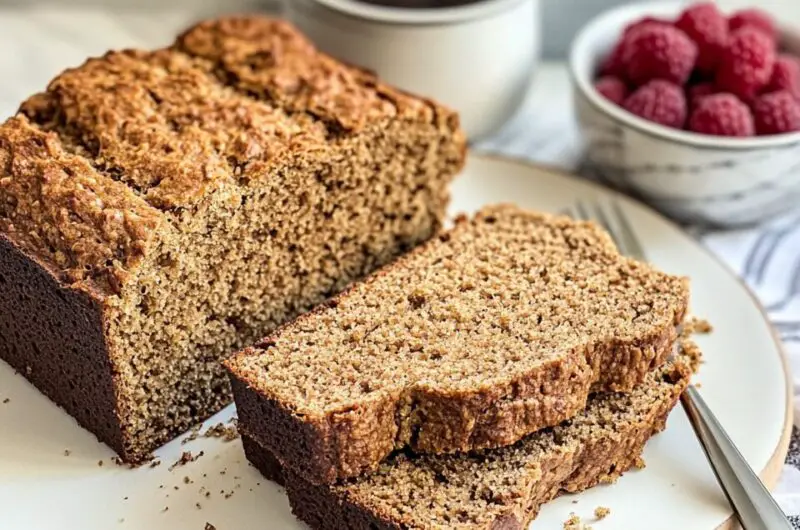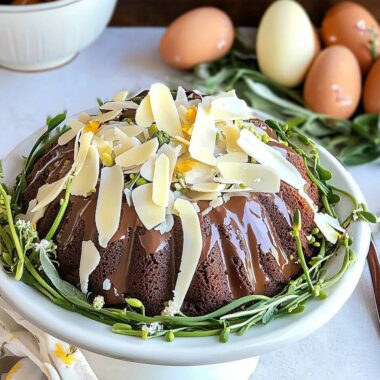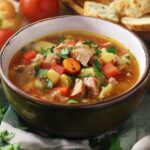Irish Brown Bread is a cherished staple in Irish cuisine, known for its wholesome ingredients and robust flavor. This traditional soda bread combines stoneground whole wheat flour with buttermilk, resulting in a dense yet tender loaf that’s both hearty and satisfying. The inclusion of toasted wheat germ and rolled oats adds a subtle nuttiness and texture, enhancing the bread’s rustic appeal. Quick to prepare and free from yeast, this bread is perfect for those seeking a simple, authentic taste of Ireland. Enjoy it warm with a pat of butter, alongside soups and stews, or as a hearty base for sandwiches.
Full recipe:
Ingredients:
- 1¾ cups (220g) stoneground whole wheat flour
- 1¾ cups (220g) all-purpose flour
- 3 tablespoons (24g) toasted wheat germ
- 2 tablespoons (14g) rolled oats, plus extra for topping
- 1 teaspoon (6g) baking soda
- 1 teaspoon (6g) salt
- 1 tablespoon (14g) cold butter, cut into cubes
- 1½ to 2 cups (355-470ml) buttermilk
Directions:
- Preheat your oven to 425°F (220°C). Grease a 9×5-inch (23×13 cm) loaf pan and set aside.
- Toast the wheat germ by scattering it onto a baking sheet and placing it in the preheating oven for about 3 minutes, stirring once or twice to prevent burning. Remove from the oven and let it cool.
- In a large mixing bowl, whisk together the whole wheat flour, all-purpose flour, toasted wheat germ, rolled oats, baking soda, and salt until well combined.
- Add the cold butter cubes to the dry ingredients. Using your fingers, rub the butter into the mixture until it resembles coarse breadcrumbs.
- Make a well in the center of the mixture and pour in about 1½ cups (355ml) of the buttermilk. Stir gently with a wooden spoon or your hands until the dough comes together. If the dough feels too dry, gradually add more buttermilk until you achieve a soft, slightly sticky consistency.
- Transfer the dough to a lightly floured surface and shape it into a loaf. Place the loaf into the prepared pan.
- Sprinkle additional rolled oats over the top of the loaf and gently press them into the dough.
- Bake in the preheated oven for 35-40 minutes, or until the bread is golden brown and sounds hollow when tapped on the bottom. If the top browns too quickly, cover it loosely with aluminum foil during the last 10 minutes of baking.
- Remove the bread from the oven and let it cool in the pan for about 10 minutes before transferring it to a wire rack to cool completely.
Prep Time: 15 minutes | Cooking Time: 35-40 minutes | Total Time: 50-55 minutes
Kcal: Approximately 150 kcal per slice | Servings: 12 slices
Introduction
Irish Brown Bread is a beloved staple in Irish cuisine, known for its hearty texture, deep nutty flavor, and wholesome ingredients. Unlike traditional white soda bread, which uses only white flour, Irish Brown Bread incorporates whole wheat flour, giving it a rich, earthy taste and a more nutrient-dense profile. This rustic bread has been a part of Irish households for generations, providing a quick, reliable, and satisfying accompaniment to soups, stews, cheeses, and even a simple spread of butter and honey. In this guide, we’ll explore the history of Irish Brown Bread, why it’s a fantastic addition to your diet, and how you can easily make it at home with our fail-proof recipe.
The History of Irish Brown Bread
Irish Brown Bread traces its origins back to the 19th century, when baking soda became widely available in Ireland. Before this, leavened bread relied on yeast, which required longer fermentation times and was less reliable for home baking. With the introduction of baking soda (or bicarbonate of soda), Irish households could quickly prepare loaves of bread that didn’t require proofing or rising time. Unlike white soda bread, which was more common in wealthier households, brown soda bread was a staple among rural communities. Whole wheat flour was more affordable and widely available, making it an essential ingredient in daily bread-making. The bread was baked in hearth ovens or cast iron pots over an open fire, giving it a slightly crisp crust and a dense yet tender crumb. Today, Irish Brown Bread remains a symbol of Ireland’s culinary heritage. It is enjoyed in homes, bakeries, and restaurants across the country, served alongside classic dishes like Irish stew, smoked salmon, or even a hearty Irish breakfast.
Why Irish Brown Bread Is the Best
1. Nutritious and Wholesome
- Unlike many commercial bread varieties that contain refined flours and added sugars, Irish Brown Bread is packed with whole grains, fiber, and essential nutrients. Whole wheat flour and oats contribute to a high fiber content, which supports digestion and promotes a feeling of fullness.
2. No Yeast, No Fuss
- One of the greatest advantages of Irish Brown Bread is that it requires no yeast. This means no waiting for the dough to rise, no complicated kneading, and no risk of the bread failing due to yeast-related issues. It’s a simple mix-and-bake recipe that guarantees fresh, homemade bread in under an hour.
3. Versatile and Customizable
- Irish Brown Bread is incredibly adaptable. You can add seeds, nuts, dried fruit, or even a drizzle of honey to create different variations. It pairs wonderfully with both sweet and savory toppings—try it with butter and jam for breakfast, or serve it with cheese and smoked salmon for a traditional Irish snack.
4. A Perfect Accompaniment to Irish Dishes
- This bread is the ideal companion for many Irish recipes, including seafood chowder, beef and Guinness stew, and traditional Irish soups. Its slightly nutty, wholesome flavor enhances the richness of these dishes without overpowering them.
5. Great for Beginners
- Even if you’ve never baked bread before, Irish Brown Bread is a great place to start. The dough comes together quickly, and since it doesn’t require yeast, there’s no risk of over-proofing. The result is a delicious, homemade loaf that looks and tastes impressive with minimal effort.
Health Benefits of Irish Brown Bread
High in Fiber
- Thanks to whole wheat flour and oats, this bread provides a generous amount of fiber, which supports healthy digestion, regulates blood sugar levels, and contributes to long-lasting energy.
Rich in Essential Nutrients
- Whole wheat flour is packed with essential vitamins and minerals, including B vitamins, iron, magnesium, and antioxidants that promote overall health.
Low in Sugar and Preservatives
- Unlike store-bought bread, which often contains artificial preservatives and excess sugar, homemade Irish Brown Bread is made with natural ingredients, making it a healthier option.
Supports Heart Health
- Whole grains are known for their heart-protective benefits. The fiber in Irish Brown Bread can help lower cholesterol levels and reduce the risk of heart disease.
Serving Suggestions
- With Butter and Honey – A simple yet delicious way to enjoy this bread.
- Alongside a Traditional Irish Breakfast – Serve with eggs, sausage, bacon, and black pudding.
- With Smoked Salmon and Cream Cheese – A classic Irish pairing.
- Dipped in Soups or Stews – The perfect bread for soaking up rich broths.
- As a Base for Open-Faced Sandwiches – Top with cheese, ham, or avocado for a wholesome meal.
Frequently Asked Questions
Can I Make Irish Brown Bread Without Buttermilk?
- Yes! If you don’t have buttermilk, you can make a substitute by mixing 1½ cups of milk with 1 tablespoon of lemon juice or vinegar. Let it sit for 10 minutes before using.
How Do I Store Irish Brown Bread?
- Wrap the bread in a clean kitchen towel and store it at room temperature for up to 3 days. For longer storage, freeze the bread in slices and toast as needed.
Can I Add Seeds or Nuts?
- Absolutely! Sunflower seeds, flaxseeds, or walnuts make great additions for extra texture and nutrition.
Why Did My Bread Turn Out Too Dense?
- Overmixing the dough can result in a dense loaf. Stir the ingredients gently and avoid over-kneading for the best texture.
Conclusion
Irish Brown Bread is a timeless classic that brings warmth, tradition, and nourishment to every meal. Whether you enjoy it fresh out of the oven with butter or as a side to a hearty stew, this bread is a must-have in your recipe collection. Simple, wholesome, and delicious—this is Irish baking at its best! Ready to bake your own loaf? Try this recipe today and experience the taste of authentic Irish Brown Bread in your home!








